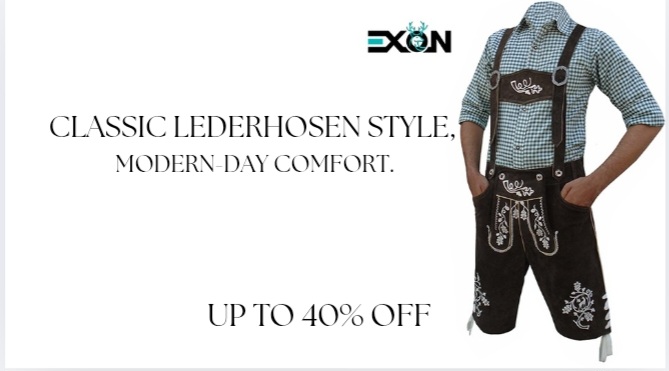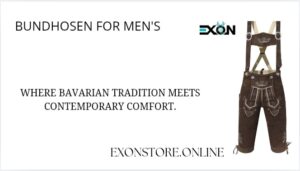When it comes to traditional German and Bavarian clothing, one garment stands out as an enduring symbol of culture, pride, and heritage: lederhosen.
These short or knee-length leather breeches have been worn by men for centuries, originally designed as sturdy workwear but later transformed into a fashionable representation of Bavarian identity.
Today, lederhosen are not just reserved for folk festivals like Oktoberfest but are also appreciated for their craftsmanship, durability, and cultural value.
For men who want to connect with tradition while showcasing style, lederhosen offer the perfect balance of practicality and elegance.
The Historical Roots of Lederhosen
Lederhosen have a long history that stretches back to the 18th century, originating in the Alpine regions of Germany, Austria, and Switzerland.
Their name translates literally to “leather trousers,” and they were first created for farmers, hunters, and laborers who needed durable clothing for hard physical work.
Leather, unlike fabric, was strong, resistant to tearing, and could withstand rough environments.
Over time, these breeches became associated with rural communities and traditional festivities, gradually evolving from everyday wear to ceremonial attire.
During the 19th century, the popularity of lederhosen began to grow beyond the working class. Nobility and city dwellers started adopting them, particularly during hunting trips and outdoor leisure activities.
This shift helped transform lederhosen into a symbol of rustic charm and Bavarian pride, rather than just a piece of clothing meant for hard labor.
Characteristics of Men’s Lederhosen
What sets lederhosen apart from ordinary trousers is their material and unique details. Traditionally made from tanned deer leather, they are now also crafted from goat, cow, or pig leather.
The natural toughness of leather ensures that lederhosen can last for years, often becoming more comfortable and attractive with age as the material softens.
Men’s lederhosen usually feature the following key elements:
- Drop-front flap (Hosenlatz): This panel at the front is both decorative and functional, often embroidered with traditional patterns.
- Suspenders (Hosenträger): Adjustable leather suspenders with a cross strap, often decorated with embroidery, keep the breeches securely in place.
- Length variations: While short lederhosen end above the knee, there are also longer versions called kniebundhosen that extend below the knee.
- Embroidery and detailing: Designs often include oak leaves, deer motifs, or edelweiss flowers, which highlight Alpine heritage.
Modern Uses of Lederhosen
Although lederhosen are deeply rooted in tradition, their use has adapted to modern times. Today, men wear them primarily for cultural celebrations, weddings, folk festivals, and of course, Oktoberfest.
The sight of men in lederhosen, paired with checkered shirts, wool socks, and rustic shoes, is a staple image of Bavarian festivities.
However, lederhosen are more than just costumes. Many Bavarians consider them part of their identity and wear them proudly on special occasions.
Some even inherit lederhosen from previous generations, treating them as family heirlooms with sentimental value.
Outside of Germany, lederhosen are also cherished by those with German heritage or individuals who appreciate traditional fashion.
Styling Lederhosen for Men
One of the appealing aspects of lederhosen is their versatility. Men can style them in various ways depending on the occasion.
At Oktoberfest, a classic look includes pairing lederhosen with a white or checkered button-down shirt, suspenders, and knee-high socks. Rustic shoes, known as Haferlschuhe, complete the outfit.
For more formal events such as weddings or cultural ceremonies, men may choose darker leather lederhosen with intricate embroidery, paired with a tailored jacket or vest.
Accessories like feathered hats or traditional belts can add extra charm to the look. The combination of rugged leather with refined accessories creates an outfit that is both masculine and sophisticated.
Why Lederhosen Remain Popular
The enduring popularity of lederhosen among men lies in their unique blend of tradition, durability, and style. Unlike fast fashion, a good pair of lederhosen can last decades, becoming even more valuable with time.
They also provide men with a way to honor cultural heritage while standing out in a crowd. In a world where fashion come and go, lederhosen remain timeless, representing authenticity and pride.
Additionally, lederhosen have gained international attention thanks to Oktoberfest celebrations worldwide.
From Munich to New York, Sydney to São Paulo, men donning lederhosen bring Bavarian culture to life on a global stage. This widespread appeal ensures that lederhosen remain relevant for future generations.
Conclusion
Lederhosen for men are far more than just traditional Bavarian shorts—they are a living symbol of heritage, identity, and craftsmanship.
With their sturdy leather construction, intricate embroidery, and versatile styling options, lederhosen offer a unique combination of practicality and elegance.
Whether worn at Oktoberfest, a wedding, or passed down as a family heirloom, they carry with them centuries of history and pride.
For men who want to celebrate tradition while embracing timeless fashion, lederhosen remain an unmatched choice that continues to captivate wearers around the world.







